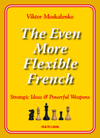 The Even More Flexible
French
The Even More Flexible
French
Strategic Ideas & Powerful Weapons
by Viktor Moskalenko
2015
New in Chess
http://www.newinchess.com/
363 pages
Price € 26,95
ISBN 978-90-5691-574-2
The Even More Flexible French is more than an expanded update from
Moskalenko’s best selling work The Flexible French which appeared back
in 2008.
Chess does not stand still, and as we van read in this book Moskalenko
is responsible for modern main lines as we for example can see in the
popular MacCutcheon: Erdogdu,Mert (2513) - Moskalenko,Viktor (2538)
[C12]
Ankara Angora Ankara (1), 22.02.2010
1.e4 e6 2.d4 d5 3.Nc3 Nf6 4.Bg5 Bb4 5.e5 h6 6.Be3 Ne4 7.Qg4 g6 8.a3
Bxc3+ 9.bxc3 c5 10.Bd3 h5 11.Qf4 g5 12.Qf3 Nxc3 13.dxc5 d4 14.Bd2 Nc6
15.Qf6 Qxf6 16.exf6 Na4 17.Bxg5 Nxc5 18.Nf3 Nxd3+ 19.cxd3 b6 20.Rc1 Bb7
21.Ke2 Rd8 22.Rc4 Rd5 23.Rhc1 Kd7 24.h4 Rc8 25.R4c2 e5 26.Nd2 Ba6
27.Ne4 Rb5 28.Rd1 Rb3 29.Bc1 Rg8 30.g3 Nd8 31.Rb2 Rxb2+ 32.Bxb2 Ne6
33.Kd2 Nc5 34.Nxc5+ bxc5 35.a4 Rg6 36.Rc1 Rxf6 37.Ke1 Rc6 38.Ba3 Kd6
39.Kd2 f5 40.f3 Kd5 41.g4 fxg4 42.fxg4 c4 43.gxh5 c3+ 44.Kc2 Rf6 45.Rd1
Rf2+ 46.Kb3 Rh2 47.Be7 c2 48.Rg1 Bxd3 49.h6 Rd2 50.Ba3 Rd1 51.Rg3 Rb1+
0-1,
Moskalenko writes after 10….h5! The right method in the MacCutcheon is
the Black Jet counteraatack with …h7-h5 and g7-g5! Before the Flexible
French was published 2008,only three games have been played with t his
concept.Now it has become the main line.
Some authors like to lift with Moskalenko’s idas as we can see in the
work from Aagaard & Ntirlis Playing the French Quality Chess
2013,but this work can not stand-up against this creative work with
highly instructive text from Moskalenko.
This book is not only a French repertoire book where Moskalenk goes for
lines as the Black Queen Blues 1.e4 e6 2.d4 d5 3.Nc3 Bb4 4.e5 c5 5.a3
Bxc3+ 6.bxc3 Qa5 7.Bd2 Qa4.
Bill Hook played the top board for the British Virgin Islands at 17
Chess Olympiads.In 1970 at the Siegen Olympiad he used his beloved
queen manoeuvre against Bobby Fischer and easy equalized but later
lost: Fischer,Robert James - Hook,William [C18]
Siegen ol (Men) Siegen (5), 1970
1.e4 e6 2.d4 d5 3.Nc3 Bb4 4.e5 c5 5.a3 Bxc3+ 6.bxc3 Qa5 7.Bd2 Qa4 8.Qg4
Kf8 9.Qd1 b6 10.h4 Ne7 11.h5 h6 12.Rh4 Ba6 13.Bxa6 Nxa6 14.Rf4 Qd7
15.Qf3 Nc6 16.Nh3 Rc8 17.g4 Qe8 18.g5 Ne7 19.gxh6 gxh6 20.Rf6 Nf5
21.Nf4 Ke7 22.Nxd5+ Kd8 23.Ne3 Nxe3 24.Bxe3 Rc7 25.dxc5 Nxc5 26.Rd1+
Ke7 27.Bxc5+ bxc5 28.Rxe6+ 1-0.
Interesting to mention is the new key move from the Dutch Twan Burg:
1.e4 e6 2.d4 d5 3.Nc3 Bb4 4.e5 c5 5.a3 Bxc3+ 6.bxc3 Qc7 7.Qg4 f5 8.Qg3
Nc6 9.Ne2 Kf7!
New in Chess speaks of a update with it’s twelve new chapters and 28
more games but I would prefer the words a complete new work!
Conclusion: This new work from Moskalenko has become a complete new
book on the French!
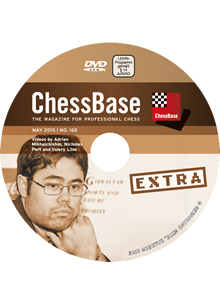
ChessBase Magazine
extra issue 165
May 2015
Videos by Adrian Mikhalchishin,Valery Lilov and Nicolas
Perth
ChessBase
http://www.chessbase.com
E-Mail
info@chessbase.com
ISSN 1432-8992
Euro 12.99
This latest ChessBase Magazine is good for 18983 entries and all
played between February and April from this year.
A nice and modern example is : L'Ami,Erwin (2605) - Oranje,Richard
(2129) [C56]
Delft Prinsenstad op-A 8th Delft (5), 05.04.2015
1.e4 e5 2.Nf3 Nc6 3.d4 exd4 4.Bc4 Nf6 5.0-0 Nxe4 6.Re1 d5 7.Bxd5 Qxd5
8.Nc3 Qa5 9.Nxe4 Be6 10.Neg5 0-0-0 11.Nxe6 fxe6 12.Rxe6 Qf5 13.Qe2 Bc5
14.Bg5 d3 15.cxd3 Rxd3 16.Re1 h6 17.Bh4 g5 18.Bg3 Bb6 19.a4 h5 20.Rxc6
bxc6 21.Ne5 Rxg3 22.hxg3 Kb7 23.Qf3 Qxf3 24.gxf3 Re8 25.Re4 h4 26.Kg2
h3+ 27.Kxh3 Bxf2 28.Kg4 c5 29.Nd3 Rxe4+ 30.fxe4 Bd4 31.b3 Be3 32.Kf5
Kc8 33.Ne5 Bd4 34.g4 a5 35.Nc4 1-0, seen this game I would play 12…Bd6!
But the black players have to care with 13.Bg5 Rde8 14.Qe1! And after
14…Rxe1 15.Raxe1 Kd7 16.Rxe8 Rxe8 17.Rxe8 Kxe8 we reach one of the most
critical positions of the 10.Neg5 variation.
Successful where this time the Latvian Gambit players: Moreira Da
Silva,Jean Marcos - Lenares,Braulio Cardoso [C40]
Vitoria da Conquista-ch 3rd Vitoria da Conquista, 14.02.2015
1.e4 e5 2.Nf3 f5 3.Nxe5 Nc6 4.Qh5+ g6 5.Nxg6 Nf6 6.Qh4 Rg8 7.Nxf8 Rg4
8.Qh6 Rxe4+ 9.Be2 Qe7 10.Kf1 Rxe2 11.g3 Qe4 0-1,10.Kf1?? is an awful
mistake.
All Latvian lovers will enjoy the following game: Del Noval
Nemeshazi,Nesztor (1770) - Vallejo Nuno,Jorge (2035) [C40]
Madrid-ch sf-B Madrid (4), 13.03.2015
1.e4 e5 2.Nf3 f5 3.Nxe5 Qf6 4.d4 d6 5.Nc4 fxe4 6.Nc3 Qg6 7.f3 Be7
8.Nxe4 d5 9.Ne5 Qb6 10.Ng3 c5 11.Bd3 Nf6 12.0-0 0-0 13.Nf5 Bd8 14.dxc5
Qxc5+ 15.Be3 Qc7 16.f4 Nc6 17.Nxc6 bxc6 18.Bc5 Bxf5 19.Bxf5 Be7 20.Bxe7
Qxe7 21.Re1 Qc5+ 22.Kh1 g6 23.Bd3 Qd4 24.c3 Qxf4 25.Rf1 Qd6 26.h3 Nh5
27.Rxf8+ Rxf8 28.Qg4 Rf4 29.Qc8+ Kg7 30.Qb7+ Rf7 31.Qa6 Qg3 32.Rf1 Nf4
33.Rxf4 Rxf4 34.Qxa7+ Kh6 35.Qc7 0-1.
The heavy loaded video files go to:
Nicholas Pert who shows his game against Jaan Ehlvest, Valeri
Lilov demonstrates the move 3.b3 variation against the 2...e6
Sicilian,and the great Adrian Mikhalchishin shows us
how easy it is to down in the Najdorf System.
Conclusion: Must material for a bargain price!
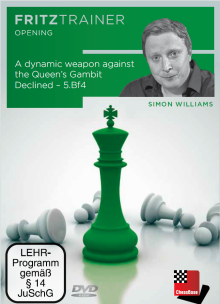
TrainingOpeningFritztrainer
A dynamic weapon against the QGD - 5.Bf4
by Simon Williams
2015
http://www.chessbase.com
E-Mail
info@chessbase.com
Price Euro 29.90
Pentium-Processor at 300 Mhz or higher, 64 MB RAM, Windows XP, Windows
Vista, Windows 7, DVD drive, mouse, soundcard
The well known chess crack Grandmaster Simon Williams provide the
use of this DVD, with a well thought white repertoire lines based on
the lines of the Queens Gambit with 1.d4 d5 2.c4 e6 3.Nc3 Be7 4.Nf3 Nf6
5.Bf4,where many say this line is the most complex of all.
As we can see in these impressive 6 hours and 39 minutes video files it
does not matter where black goes for, Simon Williams comes with an
aggressive replay as we can see in the following model game:
Speelman,Jonathan S (2645) - Short,Nigel D (2665) [D37]
Candidates qf4 London (3), 1988
Speelman surprises Short very early on in the all important candidates
match. The story goes that a game from the Soviet Championships was
published in a Norweigian newspaper, and Tisdall, who was working for
Speelman was travelling in from Norway. He picked up the paper and
found what Speelman should play! 1.d4 Nf6 2.c4 e6 3.Nf3 d5 4.Nc3 Be7
5.Bf4 '!?' This line is the 'modern' approach to this position and it
has been a move that I have been playing for some 20 years now. The
other main line is Bg5, there are advantages and some disadvantages of
placing the bishop on f4.
Advantages
f4 is a more active diagional, the position is less likely to lead to
mass exchanges. After Bg5 White will often exchange the knight on f6 or
bishop on e7. This is less likely with the bishop on f4.
There is pressure against along the h2-b8 diagional.
Disadvantages
White places less pressure on the centre. The bishop on g5 places
pressure on Blacks d5 square.
I am going to recommend the most aggressive, yet correct variations
possible! 5...0-0 6.e3 This is the most logical move. [6.a3!? is an
interesting way to stop the ever popular Nbd7, due to Nb5. On the
downside this move does little to effect things in the centre, meaning
that Black can now play ...b6. 6...b6! a logical answer to Whites move
on the 'wing'.(6...Nbd7?! 7.Nb5 White has now stopped the annoying
check on b4. 7...Ne8 8.e3 c6 9.Nc3²) ] 6...c5 Is the old way in
which Black used to play this position, but this move remains popular
to this day. [6...Nbd7 is the modern approach and seen on a regular
basis in top level chess.
I am now going to look at 3 different approaches for White. 7.a3 is the
safest approach, which offers White a risk free way to play for a win.
The position is most probably equal with best play, but Black has to
suffer somewhat. (7.c5 is the 'modern' treatment and seems to be what
most top players are doing nowadays, in order to try and gain an
advantage. White his aiming on his space advantage and Black will be
aiming on breaking up the queenside with moves like ...b6 and ...a5.
7...c6 8.h3 to protect Whites bishop against Black playing ...Nh5.
8...b6 9.b4 a5 10.a3 is a typical plan.; 7.cxd5 is the final approach
that we will look at. This is less studied compared to Whites other
options, so it is a good surprise weapon. The move is also quite simple
to play and contains some sting. White often goes back to playing the
standard queenside majority attack. 7...Nxd5 8.Nxd5 exd5 9.Bd3) 7...c5
8.cxd5 Nxd5 9.Nxd5 exd5 10.dxc5 Nxc5 11.Be5 Bf6 12.Bxf6 Qxf6 13.Qd4 is
a typical continuation when White will aim against the isolated queens
pawn on d5.;
6...b6 can be a rather passive way for Black to play, this move remains
rather unpopular. 7.Bd3 Bb7 8.cxd5 exd5 9.0-0 White intends to
checkmate Black with Ne5, Qf3, Qh3 and eventually Qxh7++! 9...c5
10.Ne5;
6...c6 is a side line. Lets checkmate Black! 7.Qc2;
6...a6 Another side line.] 7.dxc5 I want to castle queenside! 7...Nc6
8.Qc2 Bxc5 9.a3 Qa5 [9...Bd7 10.b4 Be7] 10.0-0-0! This came as a
complete shock to Short! '!?' [10.b4 Bxb4;
10.Be2 dxc4 11.Bxc4;
10.Rd1] 10...Be7 11.g4!? this is the old way of playing this position.
The modern and dangerous treatment is with 11 h4, still to deal with
this over the board is extremely difficult!
Still this idea has some shock value, so it could be a dangerous weapon
to have in a players arsenal. [11.h4] 11...Rd8 [11...dxc4! 12.Bxc4 e5!
(12...Nd7 13.h4 Nde5 14.Ng5 g6 (14...Bxg5 15.hxg5) 15.Bb3 Bxa3 16.bxa3
Qxa3+ 17.Qb2 Qxb2+ 18.Kxb2 Nxg4 19.Bg3 b6 20.h5 h6 21.Nge4 g5 22.Nb5 a6
23.Nbd6 Kg7 24.Rhe1 Nf6 25.Nxf6 Kxf6 26.Ne4+ Kg7 27.Rd6 Na5 28.Rc1 Nxb3
29.Kxb3 Ra7 30.Be5+ f6 31.Nxf6 1-0 (31) Williams,S (2421)-Fox,A (2142)
Porz Erin 2002) 13.g5 exf4= this is the way to gain equality (Williams)
14.gxf6 Bxf6 15.Nd5 Ne7 16.Nxf6+ gxf6 ½-½ (48) Anand,V
(2752)-Kramnik,V (2809) Leon 2002 CBM 090 [Dautov] 17.Rhg1+ Kh8 18.e4
'!' Cifuentes. Mit diesem Zug verhindert Weiß den unangenehmen
Läuferausfall ¥c8-f5 und plant seine Aktivität
(¦d1-d6, £c2-b3) nach der Prophylaxe ¢c1-b1
wiederaufzunehmen. (18.Nd4; 18.Qe4) 18...b5 'T' Cifuentes. Die
Standardantwort, Schwarz startet sein Gegenspiel ohne Vorbereitung. a)
18...Bh3 19.Kb1 Rac8 20.Qb3 ×f7 Short; b) 18...Be6 19.Bxe6 fxe6
20.Qb3f Qc7+ (20...Qa6 Cifuentes 21.Kb1 Rad8 22.e5©) 21.Kb1 Qc6
22.Rge1 e5 23.Rc1; 19.Bd5 Nxd5 (19...Rb8? Cifuentes 20.Qc5!; 19...Be6
Cifuentes 20.Bxa8 Rc8 21.Qxc8+ Nxc8 22.Kb1 b4 23.Nd4 bxa3 24.Nc6!)
20.exd5 b4 (Nach 20...Bd7?! 21.Kb1 b4 22.Rd4! entwickelt Weiß
einen gefährlichen Angriff: 22...bxa3 23.Rxf4! .£h7 23...f5
24.Rh4 Rab8 25.Qc4! Rxb2+ 26.Ka1+-; 20...Bg4?! 21.Qe4 Qc7+ 22.Kb1 Rfe8
23.Qd4 Bf5+ 24.Ka1 Qd6 25.Ng5 Re7 26.Ne6 Qe5 27.Rge1 Qxd4 28.Nxd4 Rxe1
29.Rxe1± Mamedyarov,S-Tregubov,P/Dubai 2002) 21.axb4 Qa1+
(21...Qxb4 22.Rd4 Qd6 23.Qc6² Short) 22.Kd2 Qa6 23.Qc6 (23.Nd4?
Rd8 24.b5 Qb6 25.Qe4 Bb7, Akopian,V-Short,N/Groningen 1996) 23...Rd8
(23...Bb7!?) 24.Kc3 (24.Qxa8? Cifuentes 24...Qc4!) 24...Bb7 25.Qxa6
Bxa6 26.Rd4 Rac8+ 27.Kd2 (27.Kb3? Cifuentes 27...Rxd5!) 27...Bb7 28.Rc1
'!' Cifuentes. 28...Rxc1 29.Kxc1 Kg7 (29...Bxd5? Cifuentes 30.Kd2! Kg7
31.Ne1 f5 32.Nd3 Kf6 33.Nxf4 Ke5 34.Ke3 Rd7 35.b5 Be6 36.Nxe6 Kxe6
37.Rxd7 Kxd7 38.Kd4 Kd6 39.f4+-; 29...Rxd5 Cifuentes 30.Rxd5 Bxd5
31.Nd4 Kg7 32.Nf5+ see game) 30.Nh4 Eine Neuerung im 30. Zug - so was
sieht man selten, selbst in unserer informationsüberfüllten
Zeit! Die Stellungseinschätzung bleibt jedoch "alt", Schwarz
remisiert mühelos. (30.Ne1 Rxd5 31.Rxd5 Bxd5 32.Nd3 f3 33.Kd2 Bc6
34.Nf4 f5 35.Ke3 Kf6 36.h4 Ke5 37.Nd3+ Kd5 38.Kf4 Ba4 39.Ne5 f6 40.Nxf3
Bc2= Van Wely,L-Short,N/Wijk aan Zee 1997) 30...Rxd5 31.Rxd5 Bxd5
32.Nf5+ Dautov: 'see game' 32...Kf8 33.Kd2 Ke8 '!' Cifuentes. a)
33...Be6!? 34.Nd6 (34.Nd4 Cifuentes 34...Bd5 35.Nb5 a6 36.Nc7 Bb7
37.Kc3 Ke7 38.b5 a5 39.Kb3! Kd6 40.Na6 Kd5 (40...Bxa6 Cifuentes 41.bxa6
Kc6 42.Ka4 Kb6 43.a7+-) 41.Ka4 Kd4 42.Kxa5 Bf3 43.b4 Kd3 44.Nc5+ Ke2
45.b6 Kxf2 46.b5! Bd5 (46...Kg2 Cifuentes 47.h4 Bd5 48.Nd3! Bb7
49.Nxf4+ Kg3 50.Nd3+-) 47.b7 Bxb7 48.Nxb7 f3 49.Nd6 Ke1 50.b6 f2 51.b7
f1Q 52.b8Q±) 34...Bd7= Short;
b) 33...a6 Cifuentes 34.Kc3 Be6 35.Nd4 Ke7 36.b5 axb5 37.Kb4 Kd6
38.Nxb5+ Kd5 39.Kc3±; 34.Kd3 Kd7 35.Kd4 Be6 36.Ke4 Bxf5+ '=!'
Cifuentes. 37.Kxf5 Kc6 38.Kxf4 a) 38.h4 Cifuentes 38...Kb5 39.Kxf6 Kc4
40.h5 Kd3 41.h6 Ke2 42.Kg7 Kxf2 43.Kxh7 f3 44.Kg8 Ke1 45.h7 f2 46.h8Q
f1Q=; b) 38.f3!? Cifuentes 38...Kd5! (38...Kb5 Cifuentes 39.h4 Kc4!
(39...Kxb4 Cifuentes 40.h5 Kc4 41.h6 Kd3 42.Kxf4! Kc2 43.Kf5 Kxb2
44.Kxf6 a5 45.Kg7 a4 46.Kxh7 a3 47.Kg8+-) 40.h5 h6! 41.Kxf6 Kd4!
(41...Kxb4? Cifuentes 42.Kg7 Kb3 43.Kxh6 a5 44.Kg5 a4 45.h6 Kxb2
46.h7+-) 42.Kg7 Ke3 43.Kxh6 Kxf3 44.Kg5 Ke3 45.h6 f3 46.h7 f2 47.h8Q
f1Q 48.Qe5+ Kd2=) 39.b5 Kc4 40.h4 h5 41.Kxf4 Kd3! (41...Kxb5 Cifuentes
42.Kf5 Kc4 43.Kxf6 Kb3 44.Kg5 Kxb2 45.Kxh5 a5 46.Kg4 a4 47.h5 a3 48.h6
a2 49.h7 a1Q 50.h8Q+ Ka2 51.Qxa1+ Kxa1 52.Kf5 Kb2 53.f4 Kc3 54.Ke5! Kd3
55.f5 Ke3 56.f6 Kf3 57.Kd6+-) 42.Kf5 Ke3 43.Kxf6 Kxf3 44.Kg5 Ke4
45.Kxh5 f5 46.Kg6 f4 47.h5 f3 48.h6 f2 49.h7 f1Q 50.h8Q=; 38...Kb5
39.Kf5 Kxb4 40.Kxf6 Kb3 41.f4 Kxb2 42.f5 a5 43.Kxf7 a4 44.f6 a3 45.Kg8
a2 46.f7 a1Q 47.f8Q Qa2+ 48.Kxh7 ½-½ (48) Anand,V
(2752)-Kramnik,V (2809) Leon 2002 CBM 090 [Dautov] , und die
assistierenden Computer beschlossen, daß die Stellung remislich
ist.] 12.h3 a6 13.Nd2!? The knight on f3 often moves around this way,
to reach b3, c4 or just gain complete control of the e4 square.
13...e5?! 14.g5! Ne8 [14...exf4 15.gxf6 Bxf6 16.Nxd5±] 15.Nb3
Qb6 16.Nxd5 Rxd5 17.cxd5 exf4 18.dxc6 fxe3 19.fxe3± Bxg5 20.Kb1
bxc6 21.Bc4 Ra7 22.Rhf1 Bf6 23.Qe4 Kf8 24.Qxh7 g6 25.e4 c5 26.e5 Bg7
27.e6 1-0.
Included is an exclusive database of 50 entries.
Conclusion: This DVD is a must for all Queen Gambit lovers!
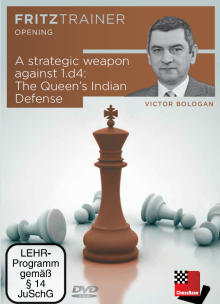
TrainingOpeningFritztrainer
A strategic weapon against 1.d4: The Queen's Indian Defense
by Viktor Bologan
2015
http://www.chessbase.com
E-Mail
info@chessbase.com
Price Euro 29.90
Pentium-Processor at 300 Mhz or higher, 64 MB RAM, Windows XP, Windows
Vista, Windows 7, DVD drive, mouse, soundcard
The great GM Victor Bologan covers with 19 video files,two extra
databases where one has a impressive 152 entries and the other one a
other 21 extra text files,
the latest developemets and strategies of the Queens’s
Indian,that runs with the moves 1.d4 Nf6 2.c4 e6 3.Nf3 b6.
Many top players as world champions have played this line but the
basics of the opening was
developed early in the 20th century,just after the first world war,by
players asAlekhine,Bogoljubow and Nimzowitsch.
The Miles variation starts with 1.d4 Nf6 2.c4 e6 3.Nf3 b6 4.Bf4 and was
the pet line of the late Tony Miles who employed the variation
constantly
during the 1970s and 1980s,where he created a whole new branch of
theory.
Interesting to mention is the following model game: Rohde,Michael A
(2550) - Miles,Anthony J (2580) [E12]
USA-ch USA (5), 1989
[Schussler]
1.d4 Nf6 2.Nf3 e6 3.c4 b6 4.a3 Ba6 5.Nbd2 Bb7 6.Qc2 d5 7.cxd5 exd5 8.g3
Bd6!? Instead of the previously played 8. - ¥e7. 9.Bg2 Nbd7 10.0-0
0-0
11.Nh4 Re8 12.Nc4?!= 12.¤df3!? 12...Bf8 13.Bf4?! Ne4 14.Ne5 Nxe5
15.dxe5 [15.Bxe5 f6! 16.Bxc7 Rc8 17.Bxd8 Rxc2-+ (Miles)] 15...g5!
16.Bxe4 dxe4
17.Rad1 Qe7 18.Nf5 Qe6 19.Nd4 Qh3 20.Bxg5 Rxe5 21.Bh4 Bd6 22.f4
22.¢h1! 22...Rc5-+ 23.Qa4 b5 24.Qb3 e3 25.Nf3 Re8 26.Rd3 Rh5
27.Qc3 Re6
28.Rxd6 [28.Rxe3 Rxe3 29.Qxe3 Bc5-+] 28...cxd6 29.Qc7 Bxf3 30.Rxf3 Rc5
31.Qd8+ Kg7 32.Rf1 Rg6 33.Qe7 Rh5 34.Qxe3 Qxh4 0-1.
Bologan does not only cover theory lines but takes the time for a
strategic explanation of all lines.
Running time is 5 hours and 10 minutes.
Conclusion: One of those super made
ChessBase Openings DVD’s!
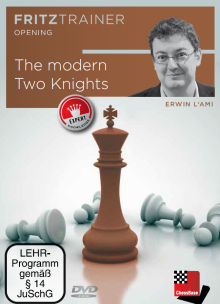 TrainingOpeningFritztrainer
TrainingOpeningFritztrainer
The modern Two Knights
by Erwin l'Ami
2015
http://www.chessbase.com
E-Mail
info@chessbase.com
Price Euro 29.90
Pentium-Processor at 300 Mhz or higher, 64 MB RAM, Windows XP, Windows
Vista, Windows 7, DVD drive, mouse, soundcard
The well known GM Erwin I’Ami digs for ChessBase into the world
of the classic line of the Two knights Defence, with
the line 1.e4 e5 2.Nf3 Nc6 3.Bc4 Nf7 4.Ng5 d5 and Erwin I’Ami is
not shy, to dig in lines as for example the Fegatello
{Fried Liver} Attack as we can see in the following well analysed model
game where white sacrifices a piece for a raging attack:
Two Knights 4.Ng5 - 4...d5 5.ed5 Nxd5 6.Nxf7 [C57]
[EA]
1.e4 e5 2.Nf3 Nc6 3.Bc4 Nf6 4.Ng5 d5 5.exd5 Nxd5 6.Nxf7 [6.d4] 6...Kxf7
7.Qf3+ Ke6 8.Nc3 Ncb4 [8...Nce7 9.d4 c6 10.dxe5f] 9.0-0 [9.a3 Nxc2+
10.Kd1 Nxa1 11.Nxd5 Qh4! (11...Kd6 12.d4 Be6 13.Re1 b5 (13...h5 14.Qe4
Kd7 15.Nb6+ cxb6 16.Qxb7+ Kd6 17.Bd2 Nc2 18.dxe5+ Kc5 19.Bxe6 Nxe1
20.Kxe1 Rh6 21.Be3+ Kb5 22.Bd7+ Qxd7 23.Qxd7+ Ka6 24.Bxh6 gxh6 25.b4 h4
26.e6 h3 27.g4 1-0 (27) Krüger,H (2423)-Fonseca,P (1918) ICCF
2008; 13...c6 14.Rxe5 Bxd5 15.Rxd5+ cxd5 16.Qxd5+ Kc7 17.Bf4+ Qd6
18.Qc5+ Kd7 19.Bb5+ Ke6 20.Qc4+ Kf6 21.Be5+ Qxe5 22.dxe5++-) 14.Nb4
(14.Rxe5!? bxc4 15.Nf4+-) 14...bxc4 15.Qc6+ Ke7 16.Bg5+ Kf7 17.Bxd8
Rxd8 18.Qxc7+ Rd7 19.Qxe5 Rd6 20.d5 Bd7 21.Qf4+ Kg8 22.Qxc4 a5 23.Nd3
a4 24.Nc5 h5 25.Nxd7 Rxd7 26.d6+ Kh7 27.Re6 g6 28.Rxg6 1-0
Shirov-Sulskis, Tromso 2014) 12.Nb6+ (12.Nxc7+ Kd7 13.Qf7+ Qe7 14.Nxa8
Qxf7 15.Bxf7 Bc5µ) 12...Ke7 13.Nxc8+ (13.Qf7+ Kd8 14.Nxa8 Bd7-+;
13.Nxa8 Bg4!) 13...Rxc8 14.d3 Kd8 15.Be3 c6³;
9.Bb3 c6 10.a3 Na6 11.Nxd5 cxd5 12.d4 Kd6 (12...Be7 13.c4 Qd6 14.0-0
(14.c5 Qc6 15.0-0 Rf8 16.Qh5 (16.Qg3 Kf7! 17.Qf3+ Ke8!) 16...Rf5
17.Qxh7 Kf7 18.Bd2 exd4 19.Bc2 Qg6 20.Qxg6+ Kxg6 21.g4 Nxc5 22.Rad1
Bf6÷) 14...e4 15.Qh5 (15.cxd5+ Kd7 16.Qg4+ Kd8 17.Qxg7 Rf8
18.Qe5 Nc7 19.Qxe4 Qg6 20.Qxg6 hxg6 21.Bh6 Rf5 22.Rfe1 Nb5 23.Be3 Rf8
24.Rac1 Bd7 25.Bh6 Rf5 26.g4 Rf3 27.Bd1 Rd3 28.a4 Nd6 29.Be3 Rxd1
30.Rexd1 Bxg4 31.Rd3 Kd7 32.Rdc3 Bd8 33.Bf4 Bb6 34.Be5 Rf8 35.f4 Rg8
36.Ra3 Bd8 37.Kf1 Bf5 38.Ke2 Re8 39.Rg1 Bb6 40.Rag3 Bxd4 0-1 (40)
Denisov,T (2078)-Schroeder,M (2440) ICCF 2014) 15...Nc7 16.c5 Qc6
17.Bf4f) 13.Qxd5+ (13.0-0 Kc7 14.dxe5 Be6 15.Rd1 Bc5 (15...Be7 16.Bxd5
Qc8 17.c4 Kb8 (17...Bg4 18.Qg3 Bxd1 19.e6++-) 18.Be3©) 16.Bxd5
Bxd5 17.Rxd5 Rf8! 18.Rxd8 Rxf3 19.Rxa8 Rxf2 20.b4 Bb6 21.Bf4 Rxf4+
22.Kh1 Nb8 23.Re1 Rf7!? (23...Nc6 24.e6 Bf2 25.g3 (25.Re2 Be3 26.g3
Re4) 25...Bxe1 26.gxf4 Bh4 27.b5 Nd8 28.f5 g6=) 24.e6 Re7 25.Re4 Nc6
26.c4 Kd6 27.c5+ Kd5") 13...Kc7 14.Qxe5+ Qd6÷;
9.Qe4 c6 10.a3 Na6 11.d4 Nac7! 12.f4 Kf7 13.fxe5 Ke8 14.Bd3 g6"] 9...c6
10.d4 Qf6 [10...Nxc2 11.dxe5 Nxa1 12.Rd1+-;
10...Kd7 11.a3 Nxc3 12.axb4 Nd5 13.Bxd5 cxd5 14.Ra5 Qf6 15.Rxd5+ Kc7
16.Qg3±;
10...Kd6 11.Bg5!?] 11.Qd1!? [11.Qe2 Kd7 12.dxe5 Qf5";
11.Qe4 Qf5!] 11...Ke7 [11...exd4 12.Ne4 Qf5 13.c3 dxc3 14.bxc3 b5
15.Bb3 Kd7 16.cxb4 Qxe4 17.Re1 Qf5 18.Bxd5 cxd5 19.Qd4 Bb7 20.Bf4 Qf6
21.Be5 Qb6 22.Qg4+ Qe6 23.Qxe6+ Kxe6 24.Bxg7+ Kd7 25.Bxh8+-
Schroeder-Haas, ICCF 2014;
11...Kd7 12.dxe5 Qxe5 (12...Qf5) 13.Re1f] 12.Re1 Qg6 [12...Nxc3 13.bxc3
Nd5 14.Rxe5+ (14.Bg5 Qxg5 15.Rxe5+ Qxe5 16.dxe5 Be6") 14...Kd7 15.Bg5
Qf7 16.Bb3 Kc7 17.c4 Nf4 18.c5 Nd5 19.Qe1 b6 20.Bxd5 cxd5 21.Qc3+-]
13.a3 Nxc3 14.bxc3 Nd5 15.Rxe5+ Kd8 [15...Kf7 16.Qf3+ Qf6 17.Bxd5+ cxd5
18.Qxd5+ Be6 19.Qxb7+ Be7 20.Bg5+-] 16.Bg5+ [16.Bxd5 cxd5 17.Rxd5+ Bd7
18.Qf3 Bd6 19.Rb1 h6 20.Bf4 Bxf4 21.Qxf4 b6÷] 16...Kc7
[16...Be7! 17.Bxe7+ Nxe7 18.d5 c5 a) 18...Bd7 19.dxc6 Nxc6 (19...Qxc6
20.Bb5 Qc7 21.Qxd7+ Qxd7 22.Bxd7 Kxd7 23.Rd1+ Ke8 24.Rde1+-) 20.Rd5
(20.Re6 Qf5 21.Rb1 Kc8 (21...Rc8!?) 22.Rxb7 Bxe6 23.Ba6 Nb8 24.Rxb8+
Kc7 25.Rb7+ Kc6!) 20...Qe8 (20...Qf7 21.Rd6 Qxc4 22.Rxd7+ Kc8 23.Qd6
Nb8 24.Rxg7±) 21.Qg4 (21.Rb1!? Rc8 22.Rxb7 Rc7 23.Rb1 Rf8
24.Bb5©) 21...Kc7 22.Qg3+ Kc8 23.Qxg7 Rg8 24.Qxh7 Rh8
25.Qd3²;
b) 18...cxd5 19.Bxd5 Qf6 20.Bxb7+ Bd7 21.Rd5 Nxd5 22.Qxd5 Rb8 23.Rd1
Qe7 24.Bc6±; 19.d6 Nc6 20.Rxc5 (20.Re3 Bd7 21.Qd5 Qf5 22.Qd2
Kc8÷) 20...Bd7÷] 17.Qf3 h6 [17...Bd6 18.Bd3!] 18.Qg3 Qd6
[18...Bd6 19.Bd8+!] 19.Bd2 b6 [19...g5 20.Bxd5 cxd5 21.c4! dxc4
22.Bb4+-] 20.a4 Bd7 [20...Kb7 21.a5 Bd7 22.a6+ Kc7 23.Bxd5 cxd5 24.c4
dxc4 25.Bf4 g5 26.Qf3 Bc6 27.Re7+ Kd8 28.Re8+ Kxe8 29.Qh5+ Kd7 30.Bxd6
Bxd6 31.Qf7+ Kd8 32.Qe6 Kc7 33.Qxc4±] 21.Ba6 Kd8 22.c4 Ne7
[22...Nc7 23.c5 Qf6 24.Ra3 Nxa6 25.Rf3 Qxf3 26.Qxf3 Nc7 27.Bxh6 Kc8
28.Bd2±] 23.c5 Qxd4 24.Bc3 Qg4 25.Qd3 Qg6 26.Qc4 1-0
Schroeder-Gagliardi, ICCF 2014.
Included is an extra well filled I’Ami database with over 90
entries!
Running time is 4 hours and 27 minutes.
Conclusion: One of the best works that
I have ever seen on the Two Knights Defence!
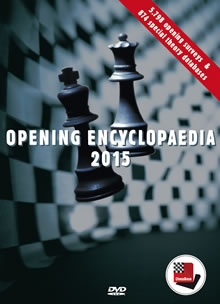 ChessBaseDatabase
ChessBaseDatabase
Opening Encyclopedia 2015
2015
http://www.chessbase.com
E-Mail
info@chessbase.com
Price Euro €99.90
€83.95 without VAT (for Customers outside the EU)
$94.33 (without VAT)
Pentium-Processor at 300 Mhz or higher, 64 MB RAM, Windows XP, Windows
Vista, Windows 7, DVD drive, mouse, soundcard
The new Opening Encyclopaedia 2015 holds now over 5.3 million games,
exactly counted are there 5301735 games,issue 2014 only had 4958288,
and all of them are holding the famous and only ECO code.
Where 83 500 of these games are more than excellent
annotated.
Included are over 5798 opening surveys, where many of them cover latest
developments.
With the large openings key you have a direct go to all the games.
Pleasant to mention are the 874 specialised theory databases which
gives the user a unbelievable mass of chess theory.
All games of this DVD are compressed in a Hugh openings book,that gives
the user an excellent over view of latest moves.
Included is the latest ChessBase reader for an excellent access
to all
the material on this DVD.
Conclusion: This DVD offers more chess
information than
all the Informators and New in Chess Books together!






